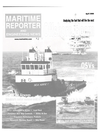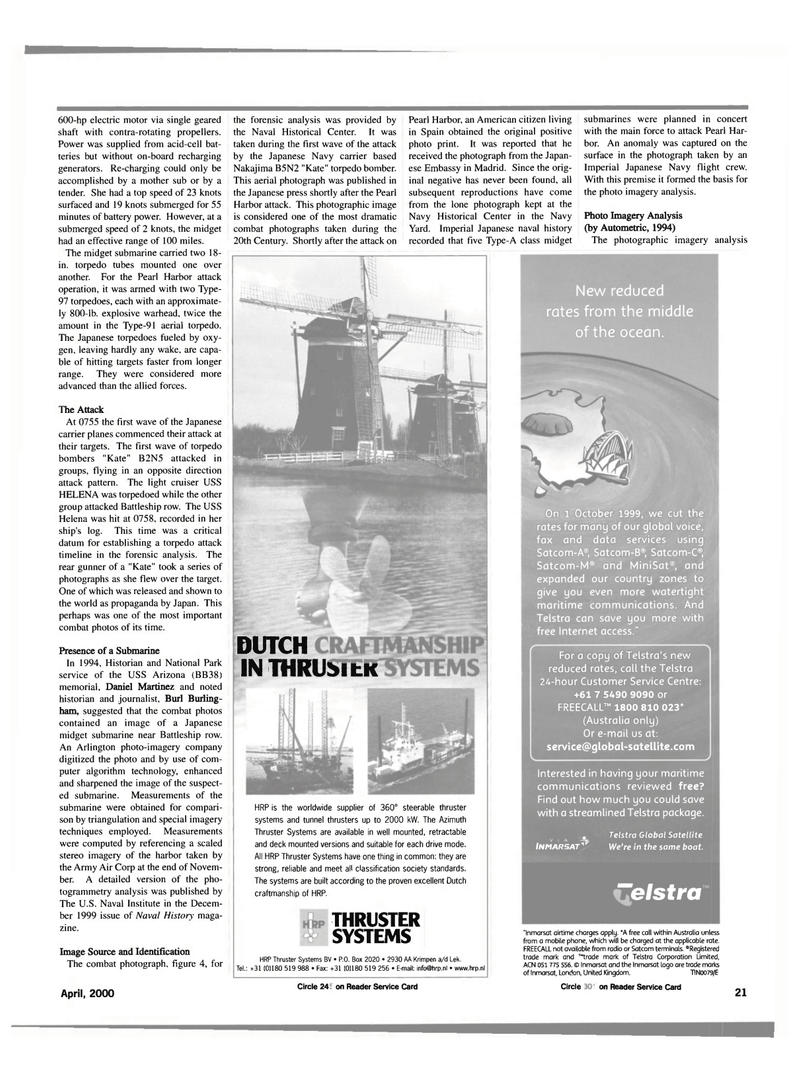
Page 21: of Maritime Reporter Magazine (April 2000)
Read this page in Pdf, Flash or Html5 edition of April 2000 Maritime Reporter Magazine
600-hp electric motor via single geared shaft with contra-rotating propellers.
Power was supplied from acid-cell bat- teries but without on-board recharging generators. Re-charging could only be accomplished by a mother sub or by a tender. She had a top speed of 23 knots surfaced and 19 knots submerged for 55 minutes of battery power. However, at a submerged speed of 2 knots, the midget had an effective range of 100 miles.
The midget submarine carried two 18- in. torpedo tubes mounted one over another. For the Pearl Harbor attack operation, it was armed with two Type- 97 torpedoes, each with an approximate- ly 800-lb. explosive warhead, twice the amount in the Type-91 aerial torpedo.
The Japanese torpedoes fueled by oxy- gen, leaving hardly any wake, are capa- ble of hitting targets faster from longer range. They were considered more advanced than the allied forces.
The Attack
At 0755 the first wave of the Japanese carrier planes commenced their attack at their targets. The first wave of torpedo bombers "Kate" B2N5 attacked in groups, flying in an opposite direction attack pattern. The light cruiser USS
HELENA was torpedoed while the other group attacked Battleship row. The USS
Helena was hit at 0758, recorded in her ship's log. This time was a critical datum for establishing a torpedo attack timeline in the forensic analysis. The rear gunner of a "Kate" took a series of photographs as she flew over the target.
One of which was released and shown to the world as propaganda by Japan. This perhaps was one of the most important combat photos of its time.
Presence of a Submarine
In 1994, Historian and National Park service of the USS Arizona (BB38) memorial, Daniel Martinez and noted historian and journalist, Burl Burling- ham, suggested that the combat photos contained an image of a Japanese midget submarine near Battleship row.
An Arlington photo-imagery company digitized the photo and by use of com- puter algorithm technology, enhanced and sharpened the image of the suspect- ed submarine. Measurements of the submarine were obtained for compari- son by triangulation and special imagery techniques employed. Measurements were computed by referencing a scaled stereo imagery of the harbor taken by the Army Air Corp at the end of Novem- ber. A detailed version of the pho- togrammetry analysis was published by
The U.S. Naval Institute in the Decem- ber 1999 issue of Naval History maga- zine.
Image Source and Identification
The combat photograph, figure 4, for the forensic analysis was provided by the Naval Historical Center. It was taken during the first wave of the attack by the Japanese Navy carrier based
Nakajima B5N2 "Kate" torpedo bomber.
This aerial photograph was published in the Japanese press shortly after the Pearl
Harbor attack. This photographic image is considered one of the most dramatic combat photographs taken during the 20th Century. Shortly after the attack on
Pearl Harbor, an American citizen living in Spain obtained the original positive photo print. It was reported that he received the photograph from the Japan- ese Embassy in Madrid. Since the orig- inal negative has never been found, all subsequent reproductions have come from the lone photograph kept at the
Navy Historical Center in the Navy
Yard. Imperial Japanese naval history recorded that five Type-A class midget submarines were planned in concert with the main force to attack Pearl Har- bor. An anomaly was captured on the surface in the photograph taken by an
Imperial Japanese Navy flight crew.
With this premise it formed the basis for the photo imagery analysis.
Photo Imagery Analysis (by Autometric, 1994)
The photographic imagery analysis
DUTCH
IN THRUSTER
HRP is the worldwide supplier of 360° steerable thruster systems and tunnel thrusters up to 2000 kW. The Azimuth
Thruster Systems are available in well mounted, retractable and deck mounted versions and suitable for each drive mode.
All HRP Thruster Systems have one thing in common: they are strong, reliable and meet all classification society standards.
The systems are built according to the proven excellent Dutch craftmanship of HRP.
THRUSTER
SYSTEMS
Tel.:
HRP Thruster Systems BV • P.O. Box 2020 • 2930 AA Krimpen a/d Lek. <-31 (0)180 519 988 • Fax: +31 (0)180 519 256 • E-mail: [email protected] • www.hrp.nl
New reduced rates from the middle of the ocean.
On 1 October 1999, we cut the rates for many of our global voice, fax and data services using
Satcom-A®, Satcom-B®, Satcom-C®,
Satcom-M® and MiniSat®, and expanded our country zones to give you even more watertight maritime communications. And
Telstra can save you more with free Internet access."
For a copy of Telstra's new reduced rates, call the Telstra 24-hour Customer Service Centre: +61 7 5490 9090 or
FREECALL™ 1800 810 023* (Australia only)
Or e-mail us at: [email protected]
Interested in having your maritime communications reviewed free?
Find out how much you could save with a streamlined Telstra package.
INMARSAT''
Telstra Global Satellite.
We're in the same boat. "elstra "Inmarsat airtime charges apply. *A free call within Australia unless from a mobile phone, which will be charged at the applicable rate.
FREECALL not available from radio or Satcom terminals. ®Registered trade mark and ™trade mark of Telstra Corporation Limited,
ACN 051775 556. © Inmarsat and the Inmarsat logo are trade marics of Inmarsat, London, United Kingdom. T1N0079/E
April, 2000 Circle 264 on Reader Service Card Circle 249 on Reader Service Card 21

 20
20

 22
22
